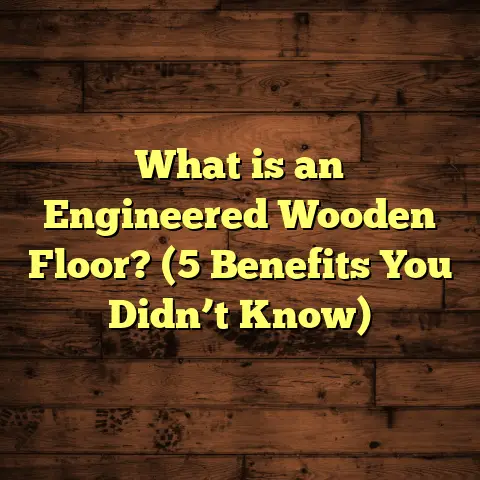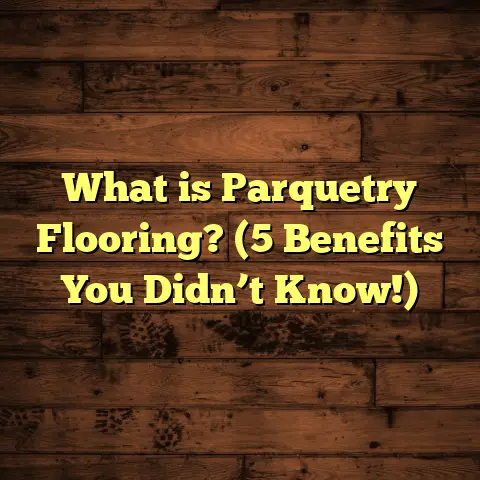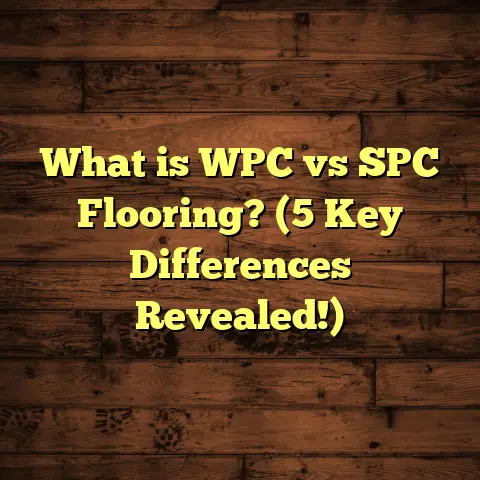What is underneath hardwood floors? (5 Secrets Revealed!)
There’s a strange paradox about hardwood floors. They appear so simple—just beautiful wooden planks laid out evenly—but underneath, the story gets complicated. I’ve been knee-deep in flooring jobs for over a decade, peeling back layers and uncovering what really supports those glossy surfaces. And let me tell you, what’s beneath hardwood floors is way more than just “wood on wood.” It’s a multi-layered system designed to keep your floors strong, stable, and looking great for years.
If you’ve ever lifted a corner of a hardwood plank or wondered why some floors squeak or warp, this article is for you. I’ll reveal five key secrets about what’s underneath hardwood floors that most people don’t know. Plus, I’ll share tips, real-life experiences, data-driven insights, and even how I use tools like FloorTally to make my flooring projects smoother and smarter.
What Is Underneath Hardwood Floors?
Let’s start by answering the basic question: what exactly lies beneath those beautiful hardwood planks?
When you look down at a hardwood floor, you’re only seeing the top layer—the wear layer or solid wood planks. But beneath that surface, there are multiple layers, each playing a vital role. These layers vary depending on the home’s construction, the type of hardwood installation, and even the age of the building.
Here’s a breakdown of the typical layers underneath hardwood floors:
1. The Hardwood Flooring Itself
This is the part everyone sees: solid hardwood or engineered wood planks. Solid hardwood is made from a single piece of wood, usually ¾ inch thick. Engineered hardwood consists of a thin top layer of real wood glued over plywood or high-density fiberboard (HDF).
But what happens when these planks meet the ground? That’s where things get interesting.
2. Underlayment: The Quiet Middleman
Underlayment is a thin layer placed directly under the hardwood. It might seem minor but plays an outsized role in your floor’s comfort and performance.
Functions of Underlayment:
- Sound Dampening: Reduces noise from footsteps or furniture movement.
- Vapor Barrier: Prevents moisture from rising up from below.
- Cushioning: Adds a slight softness underfoot.
- Leveling: Helps smooth minor subfloor imperfections.
Materials used range from foam pads, felt paper, cork sheets, to rubber mats. The choice depends on your floor type and location.
My Experience: In one downtown apartment project, we used cork underlayment to combat noise complaints from neighbors below. The difference was clear—the floor felt softer and quieter without compromising stability.
3. The Subfloor: The Workhorse Beneath
The subfloor is the thick structural layer beneath the underlayment or hardwood itself. It’s usually plywood or OSB (Oriented Strand Board), attached directly to the floor joists.
Why Subfloor Matters:
- It provides a stable base supporting the entire floor system.
- Prevents bending, squeaking, and unevenness.
- Acts as a barrier between joists and the flooring above.
In older homes, you might find tongue-and-groove boards instead of plywood. These can cause unevenness or squeaking if warped or damaged.
4. Floor Joists: The Skeleton
Joists are large wooden beams spaced 12 to 24 inches apart underneath the subfloor. They carry the weight of everything above them—furniture, people, and floors. Joists connect to wall framing and are essential for structural integrity.
If joists are compromised—due to rot, insect damage, or improper spacing—you’ll notice sagging floors or bouncing underfoot.
5. Foundation or Crawl Space
Below your joists lies either:
- A concrete slab foundation, common in basements or modern homes.
- A crawl space, an open area allowing air circulation to reduce moisture buildup.
Both have implications on moisture control and insulation needs for your floors.
Summary Table: Typical Layers Under Hardwood Floors
| Layer | Material Examples | Purpose |
|---|---|---|
| Hardwood Flooring | Solid wood, engineered | Wear surface, aesthetics |
| Underlayment | Foam, cork, felt | Soundproofing, moisture barrier |
| Subfloor | Plywood, OSB | Structural support |
| Joists | Wood beams | Load-bearing framework |
| Foundation/Crawl Space | Concrete slab or air gap | Base structure |
Secret #1: The Subfloor Is More Important Than You Think
When I first started flooring work, I underestimated how critical the subfloor is. I thought as long as my hardwood planks looked good and were nailed down properly, it was done. Boy, was I wrong.
I’ve seen countless jobs where an uneven or damaged subfloor caused problems months or years later—floors that squeaked nonstop or even buckled in places. One time, I worked on a historical house where the subfloor was made of old wooden boards that had warped severely over decades. We had to replace large sections before installing new hardwood because walking on it felt like being on a trampoline.
Key Insight: A solid subfloor ensures your hardwood floor is flat, stable, and will last decades without issues.
Data Point: Industry studies show that about 25% of flooring failures trace back to poor subfloor preparation or condition.
Secret #2: Moisture Barriers Are Non-Negotiable
Moisture is the silent enemy lurking under your floorboards. If trapped under hardwood floors without protection, moisture causes warping, cupping (edges curling upward), and mold growth.
Where Moisture Comes From:
- Ground moisture seeping through concrete slabs.
- Humidity trapped in crawl spaces.
- Plumbing leaks or spills.
Using vapor barriers—thin plastic sheets or specialized membranes—is essential especially when installing over concrete slabs or basements.
Personal Story: Once I installed hardwood in a basement without a proper moisture barrier because the client wanted to save money. Within eight months, several planks started buckling dramatically. We had to rip out the floor and install vapor barriers before re-laying new hardwood—doubling their costs.
Secret #3: Joist Condition Can Make or Break Your Floor
Joists might be out of sight, but their condition affects everything above them. If joists sag under weight or are damaged by pests like termites or rot from leaks, it shows up as bouncy, uneven flooring.
I always insist on inspecting joists before starting flooring work in older homes. Sometimes it means cutting access holes in closets or lifting carpet edges to peek beneath.
Case Study: A client’s living room had noticeable sagging floors despite new hardwood installation done by another contractor. Upon inspection, we found several termite-damaged joists that had never been treated. After replacing those joists and reinforcing others, we installed new subflooring and hardwood with no further issues.
Secret #4: Underlayment Type Changes Floor Feel and Performance
Choosing the right underlayment isn’t just about noise reduction; it changes how your floor feels when you walk on it and how well it protects against moisture and temperature changes.
For example:
- Foam underlayment is common for floating floors but offers minimal sound absorption.
- Cork underlayment is natural, eco-friendly, and excellent for soundproofing.
- Felt paper is traditional and often used beneath nail-down hardwood.
Each type suits different installation methods and environments.
Tip: If you live in an apartment or multi-story building, invest in good soundproofing underlayment to avoid complaints from neighbors below.
Secret #5: Preparation Saves Time & Money
Before laying down any hardwood floors, thorough preparation of all underlying layers saves tons of time and money later.
This means:
- Fixing uneven subfloors by sanding high spots or filling low spots.
- Replacing rotten wood in joists or subfloor.
- Installing proper moisture barriers.
- Using appropriate underlayment.
- Accounting for waste factor in material calculations (typically 5%-10%).
Skipping these steps leads to costly callbacks for squeaks, warping, or finish failure.
How FloorTally Helps Me Manage Costs for These Layers
I’m sure you’ve faced budgeting headaches with flooring projects—material prices fluctuate, labor estimates vary widely, and hidden repair costs pop up unexpectedly. Over the years, I started using FloorTally to get clearer cost estimates upfront.
This tool lets me:
- Enter local prices for materials like plywood subflooring and vapor barriers.
- Calculate labor costs based on hours needed for prep work.
- Include waste factors so I don’t run short on expensive wood planks.
- Compare different underlayment options by cost and performance.
Having everything in one place helps me give clients realistic quotes early on and avoid surprises during installation.
Diving Deeper Into Each Layer
Let’s explore each layer with more detail and real examples from my projects:
Hardwood Flooring Types Affect What’s Beneath
Solid hardwood requires nail-down installation onto a wooden subfloor. This means you need very sturdy joists spaced correctly (usually no more than 16 inches apart).
Engineered wood allows glue-down or floating installations over concrete slabs with proper moisture barriers.
Knowing this upfront changes how I prepare underneath layers and which materials I use.
Subfloor Materials & Their Pros/Cons
- Plywood: Most common today; strong and stable but can absorb moisture if not sealed.
- OSB: Cheaper alternative but less water-resistant; not ideal for moist environments.
- Old Wooden Planks: Found in vintage homes; prone to movement unless replaced or stabilized.
Joist Details You Should Know
Joists are generally spaced either:
- 16 inches on center (OC): Standard spacing providing good support.
- 24 inches OC: Common in older homes but may require thicker subflooring for stability.
Joist size also matters—typical joists are 2x8s or 2x10s depending on span length.
Real-Life Examples From My Flooring Jobs
Example 1: Kitchen Remodel with Moisture Barrier Success
I installed engineered hardwood over a concrete slab kitchen floor with radiant heat. Because kitchens have spill risks and basements tend to be moist, we used both a polyethylene moisture barrier and cork underlayment. This combo worked perfectly—no warping after two years despite heavy cooking traffic.
Example 2: Historic Home with Joist Repair
In a 1920s home renovation, we uncovered termite damage to several joists beneath the main living room floor. Rather than patching around it, we replaced entire joists and sistered in new beams before installing new plywood subfloor and solid oak flooring. The client was thrilled with the results—and no more sagging spots!
Example 3: Apartment Noise Complaint Solution
After hearing complaints about footstep noise from downstairs neighbors in a condo building, we retrofitted cork underlayment beneath floating engineered wood flooring in several units. This reduced impact noise by roughly half based on feedback—and saved potential legal hassles.
Common Questions About What Lies Beneath Hardwood Floors
Can You Install Hardwood Over Existing Flooring?
Sometimes yes—but only if existing flooring is stable and compatible. For example:
- Installing engineered wood over vinyl can work if vinyl is flat and secure.
- Nail-down solid hardwood over vinyl isn’t recommended due to lack of stability.
I always remove old carpet or damaged vinyl before installing new hardwood to avoid hidden problems later.
How Do I Know if My Subfloor Is Good Enough?
Use a straight edge to check for uneven spots greater than 3/16 inch over 10 feet—that’s too uneven for hardwood installation without leveling. Also tap around to listen for hollow sounds indicating loose boards.
What Happens If Moisture Barriers Are Skipped?
You risk wood swelling, warping or developing mold underneath—leading to costly repairs and shortened floor life.
What Is the Average Cost Adding These Layers?
Depending on home size and condition:
- Subfloor repair/replacement: $1 – $3 per sq ft
- Moisture barrier materials: $0.10 – $0.50 per sq ft
- Underlayment: $0.30 – $1 per sq ft
- Labor varies widely based on complexity
Using a tool like FloorTally helps me get precise numbers based on local rates rather than guessing.
Final Tips From My Experience
- Never Rush Prep Work: Skipping inspection or repair leads to headaches later.
- Use Quality Materials Below Surface: Cheaper underlayment or subfloor can cause long-term problems.
- Match Installation Methods with Your Layers: Nail-down vs glue-down requires different base conditions.
- Account For Waste: Always buy extra material for cuts and mistakes (usually 5%-10%).
- Ask Professionals For Inspections: Especially for older homes where hidden damage can exist.
- Consider Climate: Humidity levels affect moisture barrier needs greatly.
- Soundproof If Needed: Especially important in multi-story buildings.
- Document Conditions Before Installation: Photos and notes help if issues arise later.
I hope this detailed guide helps you understand what really supports your beautiful hardwood floors—and why those hidden layers are so important. If you’re planning a project yourself or hiring pros, knowing these five secrets will help you get better results with fewer surprises.
If you want help estimating costs more accurately for your next flooring job—including all those hidden layers—I’m happy to share how tools like FloorTally can make your life easier just like they do mine.
Got questions? Just ask—I’m here to help!





